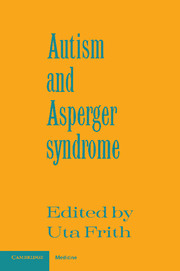Book contents
- Frontmatter
- Contents
- List of illustrations
- Acknowledgements
- 1 Asperger and his syndrome
- 2 ‘Autistic psychopathy’ in childhood
- 3 The relationship between Asperger's syndrome and Kanner's autism
- 4 Clinical and neurobiological aspects of Asperger syndrome in six family studies
- 5 Asperger syndrome in adulthood
- 6 Living with Asperger's syndrome
- 7 The autobiographical writings of three Asperger syndrome adults: problems of interpretation and implications for theory
- Name Index
- Subject Index
4 - Clinical and neurobiological aspects of Asperger syndrome in six family studies
Published online by Cambridge University Press: 18 December 2009
- Frontmatter
- Contents
- List of illustrations
- Acknowledgements
- 1 Asperger and his syndrome
- 2 ‘Autistic psychopathy’ in childhood
- 3 The relationship between Asperger's syndrome and Kanner's autism
- 4 Clinical and neurobiological aspects of Asperger syndrome in six family studies
- 5 Asperger syndrome in adulthood
- 6 Living with Asperger's syndrome
- 7 The autobiographical writings of three Asperger syndrome adults: problems of interpretation and implications for theory
- Name Index
- Subject Index
Summary
Introduction
Asperger syndrome – whatever it is – cannot be dismissed at the drop of a hat as ‘mild autism’ and thereby relegated to the status of eccentricities in a textbook on child psychiatry. Since the seminal paper by Wing (1981), interest and work in the field have so grown that one senses the presence of a true diagnostic entity – at least from the clinical point of view – which for many years has haunted child and adult psychiatrists alike, variously alluded to as ‘autism in high-functioning individuals’, ‘MBD (minimal brain dysfunction) with autistic traits’, ‘borderline personality’, ‘schizoid personality disorder’ or ‘schizotypal personality disorder’.
Hans Asperger, in his original 1944 paper (see chapter 2), described a group of patients suffering from ‘the autistic psychopathy of childhood’ who in some respects (particularly with regard to superior language skills, perhaps also with respect to worse motor skills) appeared to differ markedly from the group of cases described by Kanner in 1943. Van Krevelen, in 1971, made a devoted attempt to conceptualize autistic psychopathy as a separate disorder. Nevertheless, Asperger's original descriptions did not, as it were, catch on, until Lorna Wing drew attention to them in her 1981 paper, in which she acknowledged the usefulness of the term Asperger syndrome while at the same time announcing that she considered it to be one among several entities within the ‘autism spectrum disorders’.
- Type
- Chapter
- Information
- Autism and Asperger Syndrome , pp. 122 - 146Publisher: Cambridge University PressPrint publication year: 1991
- 114
- Cited by

